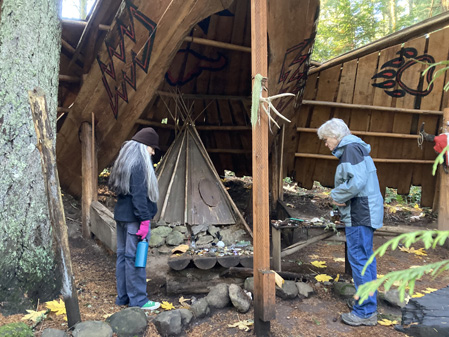
November 8, 2023: Pick A Religion, Any Religion
El took me and her long-time teacher friend Tammy to the outskirts of Portland, past the industrial district (the underbelly as I used to call it) to a place called the Vedanta Retreat; as the signage read, “a holy shrine in the lap of nature. A place of contemplation, serenity, peace, and beauty for all.” I thought that there would be a shrine or two in a small, wooded area; instead, there were 13 shrines, all spread out in a 2-3 mile area. The trail was firmly established. At the trail head we picked up a map that listed all the shrines and where they were. |
|
It was called an Ashrama and was “conceived of and planned with the expressed object of presenting to the seekers the fullest opportunity possible to cultivate their spiritual life.” As is further explained in the paper guide, “Here in the natural setting of quiet and solitude, away from the bustles and hurry of city life, they will be able to cultivate introspection and discipline, to bring out the Divine Perfection within, to its fullest manifestation.” Most faiths were represented. The first was the Holy Mother Shrine: Sri Saranda Devi (1853-1920) also known as the Holy Mother, “born in Jayrambati, Bengal, India. Sri Ramkrishna, her spiritual consort, and Guru evoked Divine Mother in her person and worshipped her. She is worshipped by many throughout the world as the embodied Divine Mother, personified compassion and love. . .” That we first visited this shrine seemed to me to be most appropriate. This was the shrine that most closely approximated Mother Nature. And this got me to thinking – what if we all worshipped female deities -- would our worship-related attitudes be different? It would be a far cry from “our heavenly father,” that’s for sure. All the shrines were similar in that they had places for offerings of various things, painted rocks, coins, medallions, included. I had painted rocks the day before, and had I known that we would be doing this pilgrimage, I would have painted rocks that were most fitting. The most elaborate shrine was the Viveananda Shrine. Swamp Viveananda (1863-1902) brought the teachings of Vendanta and the Yogas from India to the West in 1893. He participated in the Parliament of Religions as part of the famous Columbian Exposition in Chicago representing Hinduism. The walking map noted that the architectural lines and ratios represented the Orissa Style, a common medieval Hindu temple style. The front pyramidal assembly hall symbolized Shakti (relative reality) and the back sanctum sanctorum represented Shiva (absolute reality). The Jewish shrine consisted of a locked up box and there was no place to put offerings. Other represented religions that were tucked in the woods included, but were not limited to Christian, Buddhist, Native people’s, Jain, Shinto, and Baha’i. The Baha’i shrine consisted of a series of poles, in a circle – they were linked by engraved, varnished boards, each of which had a quotation from one of the two Baha’i messengers. |
|
